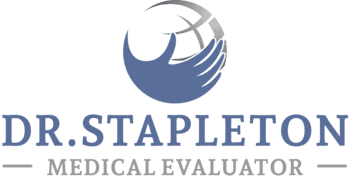Why OSHA Recordables Matter More Than Ever
Every employer in high-risk industries knows the weight of an OSHA recordable injury. Each entry on the OSHA 300 log is more than paperwork — it represents higher workers’ compensation premiums, increased scrutiny from regulators, potential production downtime, and a signal to employees about how much their safety is truly valued.
The challenge is this: many injuries that appear straightforward on paper are misclassified, poorly managed, or escalated unnecessarily, transforming what could have been a minor incident into a costly OSHA recordable. Employers often leave money on the table simply because their systems don’t integrate medical expertise early in the process.
This is where my background as a physician, consultant, and former corporate medical leader comes in. With over a decade of experience evaluating workplace injuries at companies like General Motors, Boeing, and Amazon, as well as a foundation in military medicine and public health, I help employers navigate the complex intersection of regulation, medical causation, and workforce safety. My mission is simple: reduce OSHA recordables without compromising employee trust or health.
The Cost of OSHA Recordables: More Than Just Numbers
Before discussing solutions, it’s important to understand the scope of the problem. OSHA recordables don’t just reflect injuries — they shape how a company is viewed by regulators, insurers, unions, and even customers.
– Financial impact: A higher recordable rate can drive up workers’ compensation premiums by tens or hundreds of thousands of dollars annually.
– Regulatory scrutiny: Companies with elevated incident rates often face more frequent inspections and greater liability exposure.
– Employee trust: Workers notice how management handles injuries. Mishandled cases can lead to decreased morale, more reported claims, and even union grievances.
– Productivity: Recordables often mean restricted duty or lost time. Each case not only costs in direct medical expenses but in overtime, replacement training, and workflow disruption.
In industries where margins are thin — such as moving, automotive, logistics, or manufacturing — these costs can determine competitive survival.
The Hidden Driver: Misclassification and Over-Escalation
Here’s the reality few employers recognize: a large portion of OSHA recordables are avoidable. They occur not because of deliberate negligence but because of misclassification or medical mismanagement.
Example 1: Strain vs. Recordable
A worker strains their back lifting a box. Instead of early physician intervention, the case goes straight to the ER. The ER prescribes physical therapy and prescription medication — automatically making it recordable. Yet, in most cases, early conservative care (ice, OTC medication, modified duty) would have resolved symptoms quickly without a recordable classification.
Example 2: Cumulative Trauma
A worker develops wrist pain after years on the line. Without careful causation analysis, this is quickly labeled as a work-related recordable. However, an occupational physician can evaluate risk factors, differentiate between aggravation vs. exacerbation, and often show that the prevailing factor is non-occupational degeneration, preventing unnecessary OSHA entries.
Example 3: Supervisor Training Gap
Frontline supervisors often over-refer. Without clear medical guidance, they may send employees to urgent care “just to be safe.” What begins as a minor bruise becomes a recordable when prescription meds are prescribed. Proper supervisor education dramatically reduces this reflexive over-escalation.
How My Expertise Reduces OSHA Recordables
As an Occupational Medicine physician and consultant, I provide proactive systems that prevent small injuries from becoming costly entries. My approach is rooted in three pillars: medical expertise, regulatory knowledge, and operational integration.
1. Early Triage and Medical Oversight
The single greatest lever for reducing recordables is early physician involvement.
– On-call physician support: Instead of defaulting to urgent care, supervisors can immediately consult with me. I provide real-time triage, ensuring that only cases truly requiring higher-level intervention escalate.
– Evidence-based protocols: Using ACOEM’s MDGuidelines and the AMA Guides, I design clinical pathways that outline when an injury should be managed in-house vs. externally.
– Rapid return-to-work: By integrating best practices, I ensure employees recover safely while minimizing lost or restricted duty.
This model shifts employers from reactive care to preventive management.
2. Accurate Recordability Determination
Most safety teams know the basics of OSHA recordables, but the nuances often require medical judgment.
– Distinguishing first aid vs. medical treatment: Something as simple as whether a bandage is “butterfly” vs. “dermabond” can change classification.
– Causation analysis: I evaluate whether the workplace is the prevailing factor (as Missouri law requires) or whether symptoms reflect natural degeneration, personal health factors, or non-occupational causes.
– Documentation defense: My reports provide defensible reasoning in the event of an OSHA audit or workers’ compensation dispute.
This not only keeps logs accurate but also provides legal protection.
3. Supervisor and Leadership Training
Supervisors are often the first line of defense — and the first point of failure. I train leaders to:
– Recognize the difference between “recordable triggers” and minor injuries.
– Apply simple decision trees before sending an employee to outside care.
– Communicate with employees in ways that build trust rather than fear.
This training reduces unnecessary escalation and empowers supervisors to manage safely within compliance.
4. Job Site Evaluation and Ergonomic Consulting
Not all recordables are about acute injury. Many come from repetitive strain and ergonomic issues.
With experience in hazard evaluations at Fortune 500 facilities, I provide:
– Job hazard analyses to identify high-risk tasks.
– Ergonomic redesigns that reduce strain without slowing production.
– Supervisor coaching on safe lifting, rotation schedules, and hazard reporting.
These interventions not only cut down on injuries but also demonstrate to OSHA that the company is actively addressing risk.
5. Data-Driven Insights and OSHA 300 Log Review
I don’t just prevent future recordables — I help employers make sense of their existing data.
– Reviewing OSHA 300 logs for misclassified cases.
– Identifying injury clusters by department or task.
– Tracking cost drivers across locations.
– Benchmarking against industry norms.
By turning data into action, I help companies strategically focus their safety investments.
Case Examples: What This Looks Like in Practice
Case 1: Automotive Plant
At a major automotive manufacturer, supervisors frequently referred workers to urgent care for minor strains. By introducing on-site triage protocols and training supervisors in first-aid differentiation, the company reduced recordables by 30% in one year, saving hundreds of thousands in workers’ comp premiums.
Case 2: Moving Company
At a regional moving company, employees frequently developed shoulder and back injuries while lifting heavy furniture and boxes. These cases often turned into lost-time recordables because they weren’t managed early. After conducting ergonomic assessments and implementing safe-lifting protocols, two-person lift requirements for heavier items, and rotation schedules, the company saw a significant drop in recordables. Not only did OSHA logs improve, but employees reported greater confidence in the company’s commitment to their safety.
Case 3: Logistics Warehouse
A distribution center struggled with back injuries leading to lost-time cases. With early physician involvement and strict return-to-work pathways, the majority of cases were managed without escalation. Lost-time days decreased by 40%, boosting productivity.
Why Physician-Led Consulting Works Better Than Standard Safety Programs
Many companies already invest in safety programs, but what they lack is medical interpretation. Safety professionals excel at hazard recognition and compliance, but only a physician can:
– Apply clinical judgment to distinguish recordable vs. non-recordable.
– Provide defensible causation analysis in line with AMA Guides and state law.
– Directly influence medical care pathways to minimize unnecessary escalation.
When physicians partner with employers, the result is fewer recordables, lower costs, and stronger compliance.
My Unique Background: Why I’m Different
– Dual board certification in Occupational Medicine and Preventive Medicine/Public Health.
– Certified Independent Medical Examiner with expertise in causation and impairment ratings.
– Military-trained physician with residency in Occupational Medicine for the U.S. Army.
– Experience with Fortune 500 companies (General Motors, Boeing, Amazon) conducting job-site evaluations and injury assessments.
– Peace Corps Volunteer in Niger, West Africa, working as a community health agent — bringing a global perspective to preventive health.
– Fluent in Spanish, enabling direct communication with diverse workforces.
This combination of regulatory, medical, and cultural expertise makes me uniquely positioned to bridge the gap between compliance, care, and cost.
The Win-Win: Safer Workers, Lower Costs
Reducing OSHA recordables isn’t just about cutting costs — it’s about building a culture where workers feel cared for and employers are protected.
– Employees win because they get early, appropriate medical care without unnecessary escalation.
– Employers win because they avoid inflated premiums, regulatory risk, and productivity loss.
– Insurers win because claims are appropriately managed and defensible.
When all sides win, the company builds resilience and trust — essential in today’s competitive labor market.
How I Partner With Employers
I offer tailored consulting arrangements depending on company size and needs:
– OSHA Log Audits: Reviewing past years’ records for misclassification and defense.
– Supervisor Training: Equipping leaders with practical tools to reduce over-referrals.
– On-Call Triage Support: Providing real-time physician input on injury management.
– Job Site Evaluations: Identifying ergonomic and hazard risks before they drive claims.
– Retainer Services: Offering ongoing consulting for companies that want consistent support.
Whether a company needs a one-time audit or a long-term partner, I scale services to fit.
Conclusion: The Next Step for Employers
Every OSHA recordable you prevent represents not just dollars saved, but trust earned with your workforce. With the right systems in place — led by a physician who understands both medicine and regulation — companies can transform injury management from a liability into a strategic advantage.
I’ve seen firsthand how the right interventions at GM, Boeing, Amazon, moving companies, and logistics facilities reduced recordables while strengthening culture. Now, I bring that expertise to employers across Missouri, Kansas, and Texas.
If you’re ready to reduce your OSHA recordables, lower your workers’ compensation costs, and build a healthier workforce, I’d be glad to partner with you.
📞 Dr. Austin Stapleton, MD, MPH
Founder, Stapleton Injury Advocate
☎️ 314-252-0523
📧 in**@********mp.com
🌐 staplecomp.com





